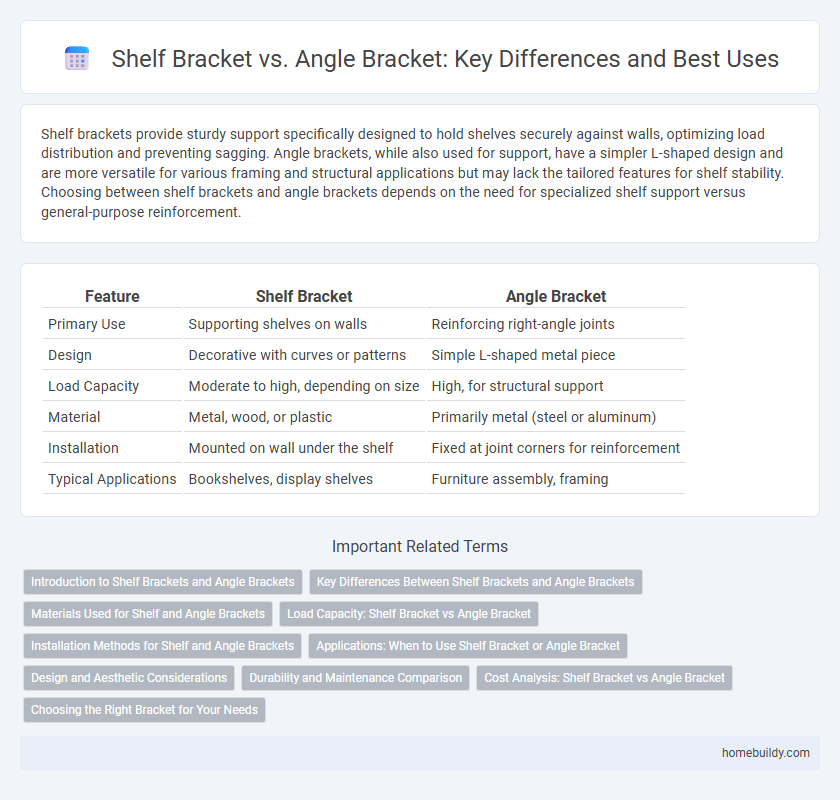Shelf brackets provide sturdy support specifically designed to hold shelves securely against walls, optimizing load distribution and preventing sagging. Angle brackets, while also used for support, have a simpler L-shaped design and are more versatile for various framing and structural applications but may lack the tailored features for shelf stability. Choosing between shelf brackets and angle brackets depends on the need for specialized shelf support versus general-purpose reinforcement.
Table of Comparison
| Feature | Shelf Bracket | Angle Bracket |
|---|---|---|
| Primary Use | Supporting shelves on walls | Reinforcing right-angle joints |
| Design | Decorative with curves or patterns | Simple L-shaped metal piece |
| Load Capacity | Moderate to high, depending on size | High, for structural support |
| Material | Metal, wood, or plastic | Primarily metal (steel or aluminum) |
| Installation | Mounted on wall under the shelf | Fixed at joint corners for reinforcement |
| Typical Applications | Bookshelves, display shelves | Furniture assembly, framing |
Introduction to Shelf Brackets and Angle Brackets
Shelf brackets and angle brackets are essential hardware components designed to support shelves and various structures. Shelf brackets typically feature a flat, horizontal arm that holds the shelf, providing stability and weight distribution, while angle brackets are L-shaped metal pieces used to reinforce joints at right angles. Understanding their distinct designs and load-bearing capacities helps in selecting the ideal bracket type for specific shelving and construction needs.
Key Differences Between Shelf Brackets and Angle Brackets
Shelf brackets are specifically designed to support shelves and usually feature a right-angled design with additional support arms or decorative elements to handle weight evenly. Angle brackets are more versatile, primarily used to join two surfaces at a right angle, often lacking the reinforced structure needed for heavy shelf loads. The key differences lie in their load-bearing capacity, design intent, and application, with shelf brackets optimized for strength and aesthetics in shelving, while angle brackets serve general structural support needs.
Materials Used for Shelf and Angle Brackets
Shelf brackets are commonly made from steel, aluminum, or heavy-duty plastic, offering strong support and resistance to corrosion for indoor and outdoor shelving. Angle brackets typically use steel or stainless steel for durability and load-bearing capacity, often coated with zinc or powder for rust protection. The choice of material directly affects the bracket's strength, weather resistance, and suitability for different shelving environments.
Load Capacity: Shelf Bracket vs Angle Bracket
Shelf brackets typically offer higher load capacity compared to angle brackets due to their design, which distributes weight more evenly along the wall and shelf. Angle brackets, often smaller and less robust, excel in supporting lighter loads or in applications with limited space. Selecting the appropriate bracket depends on the load requirements, with shelf brackets preferred for heavy-duty shelving installations requiring maximum support.
Installation Methods for Shelf and Angle Brackets
Shelf brackets typically install using screws anchored directly into wall studs, providing robust support for shelving units by distributing weight evenly; they often feature pre-drilled holes for straightforward alignment. Angle brackets require precise measurements to ensure the horizontal and vertical arms are flush against surfaces, using fasteners such as wall plugs or drywall anchors for secure attachment on various wall types. Both bracket types may involve the use of a level during installation to maintain shelf alignment and ensure stability.
Applications: When to Use Shelf Bracket or Angle Bracket
Shelf brackets are ideal for supporting horizontal surfaces like shelves, especially in residential and commercial interiors where aesthetic appeal and load distribution are important. Angle brackets suit structural reinforcement and corner joining in construction or furniture framing, providing strong right-angle support. Choose shelf brackets for visible, load-bearing support on walls and angle brackets for hidden, high-strength connections in assemblies.
Design and Aesthetic Considerations
Shelf brackets typically feature a more streamlined design that complements modern interior styles, often showcasing sleek lines and minimalistic forms. Angle brackets prioritize strength and function with utilitarian, angular shapes that may appear bulkier but provide robust support. Choosing between the two depends on balancing aesthetic preferences with the structural demands of the shelving project.
Durability and Maintenance Comparison
Shelf brackets typically offer greater durability than angle brackets due to their reinforced design and use of sturdier materials such as steel or heavy-duty aluminum. Maintenance of shelf brackets is minimal since their solid construction resists bending and corrosion, reducing the need for frequent repairs or replacements. In contrast, angle brackets, often made from thinner metals, may require more regular inspection and maintenance to prevent warping and ensure stability over time.
Cost Analysis: Shelf Bracket vs Angle Bracket
Shelf brackets generally offer a lower cost compared to angle brackets due to simpler manufacturing processes and less material usage. Angle brackets tend to be more expensive because of their robust design, which requires thicker metal and additional welding or fastening. Evaluating long-term durability and load capacity is essential, as angle brackets may reduce replacement costs despite higher initial investment.
Choosing the Right Bracket for Your Needs
Shelf brackets provide strong horizontal support specifically designed for shelving, offering a balance of weight capacity and aesthetic appeal. Angle brackets, often more compact and simpler in design, are versatile for various structural reinforcements but may not support heavy shelving loads as effectively. Choosing the right bracket depends on load requirements, installation surface, and desired visual impact to ensure stability and durability.
Shelf bracket vs Angle bracket Infographic

 homebuildy.com
homebuildy.com